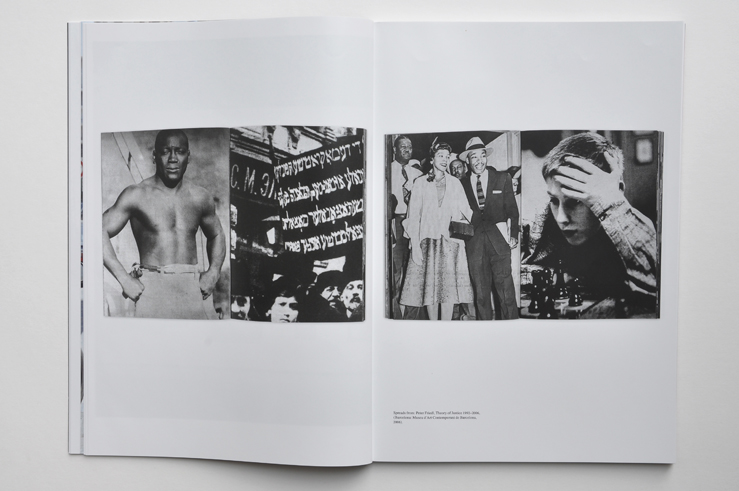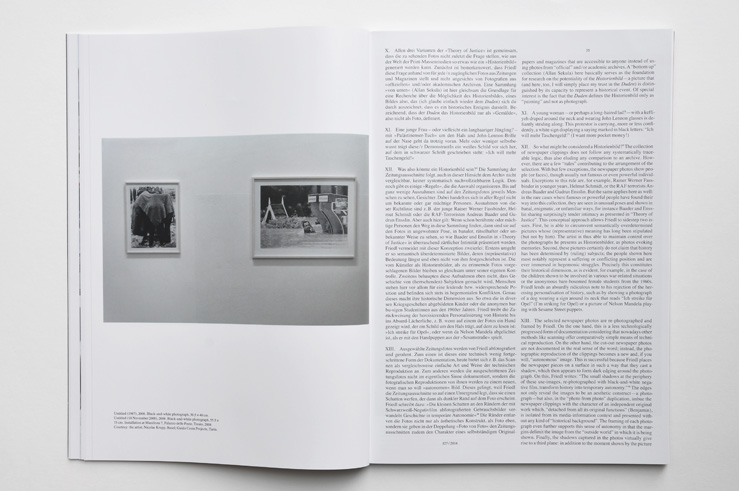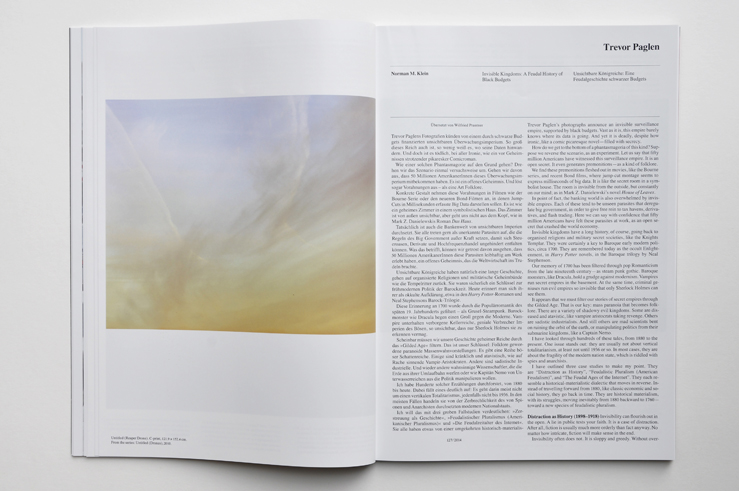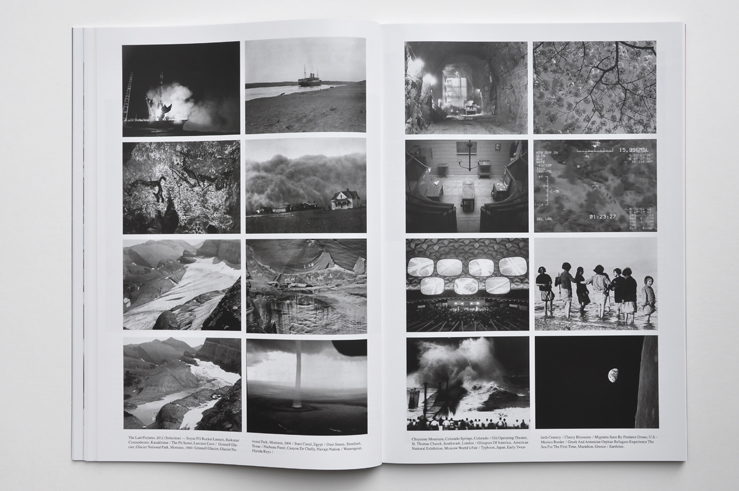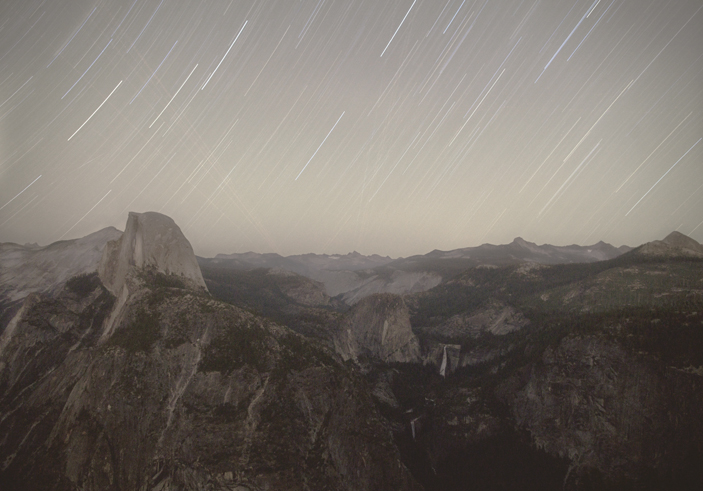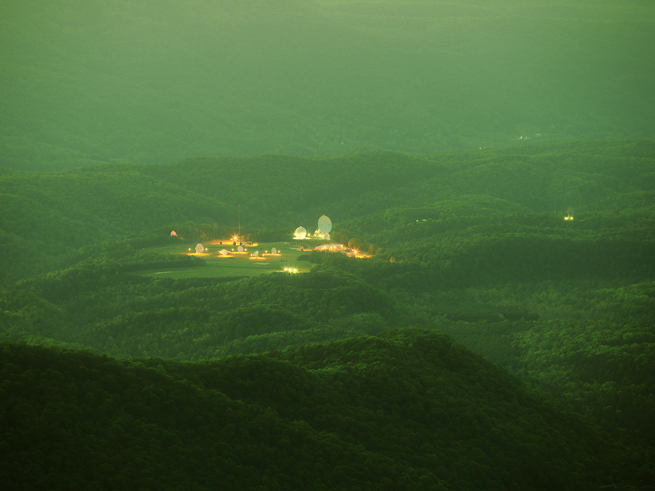Camera Austria International
127 | 2014
- STEFAN TARNOWSKI
Paola Yacoub: After the Flood. “Les fleurs de Damas“ - PAOLA YACOUB
- RAIMAR STANGE
Peter Friedl: Sixteen Fragments on “Anarchivism” - PETER FRIEDL
- NORMAN M. KLEIN
Trevor Paglen: Invisible Kingdoms: A Feudal History of Black Budgets - TREVOR PAGLEN
- ALANNA LOCKWARD
Decolonising the (White) Gaze 3 / 4. Healing Sara Bartman in the “Continent of Black Consciousness”
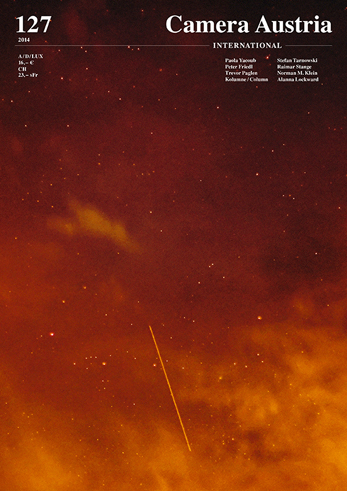
Preface
The rose merchants in Paola Yacoub’s “Les fleurs de Damas” (The Flowers of Damascus, 2002) could be Syrian spies. What is visible on Trevor Paglen’s photographs cannot be definitively identified. Even the context-eluding newspaper photos in Peter Friedl’s “Theory of Justice” (1992–2010) are (no longer) self-explanatory. The artists presented in the current issue of Camera Austria International pose the fundamental question, among others, as to which strategies are used to achieve visualisation. What is actually visible? And to what extent does the visible correspond to the speakable? What happens when the pictures themselves want to become theory, as Peter Friedl wonders in the cover text of his book Theory of Justice 1992 – 2006?
Certainly, this discussion is far from new, yet considering the countless geopolitical crises that exacerbate conventions of secrecy, surveillance, disinformation, and acts of making events invisible, the question of a politics of visibility keeps arising, perhaps in ever more brief intervals. The issue regarding the flood of images showing so many different uprisings, revolutions, and protracted civil wars, is not only about what is to be seen but what cannot be seen anymore.
Entries
Forum
Presented by Frank Wagner
Monique Jacot
Danila Tkachenko
Stephanie Kloss
Sandip Kuriakose
Anna Charlotte Schmid
Karl-Ludwig Lange
Exhibitions
Richard Prince: It’s a Free Concert
Kunsthaus Bregenz
JÖRG SCHELLER
Maha Maamoun: The Night of Counting the Years
Fridericianum, Kassel
ANNA-CATHARINA GEBBERS
Punctum: Bemerkungen zur Photographie
Salzburger Kunstverein
KATHI HOFER
Foreign Exchange (or the stories you wouldn’t tell a stranger)
Weltkulturen Museum, Frankfurt/Main
SANRA KRIŽIĆ ROBAN
Re:Search
Krakow Photomonth Festival 2014
Various locations, Krakow
FRITS GIERSTBERG
Berlin Documentary Forum 3
Haus der Kulturen der Welt, Berlin
SUSANNE HOLSCHBACH
Manifesta 10
Eremitage und verschiedene Orte, St. Petersburg
HERWIG G. HÖLLER
Berlin Biennale 8
Various venues, Berlin
T.J. DEMOS
(Mis)Understanding Photography. Werke und Manifeste
Museum Folkwang Essen
Manifeste! Eine andere Geschichte der Fotografie
Fotomuseum Winterthur
ESTELLE BLASCHKE
Anne Collier
CCS Bard Galleries, Annandale-on-Hudson
Museum of Contemporary Art Chicago
Aspen Art Museum
The Art Gallery of Ontario, Toronto
NICOLAS LINNERT
Robert Heinecken: Lessons in Posing Subjects
WIELS, Brüssel
TINA SCHULZ
Blow-Up: Antonioni’s Classic Film and Photography
Albertina, Vienna
Fotomuseum Winterthur
C/O Berlin
JAKUB MAJMUREK
Gesture,
Württembergischer Kunstverein
LAURENCE A. RICKELS
Gregor Schmoll: Orbis Pictus
Kunsthalle Krems
ANNE FAUCHERET
Vlasta Delimar: This Is I
Museum of Contemporary Art Zagreb
TANJA VERLAK
Unedited History: Iran 1960-2014
Musée d’Art Moderne, Paris
MICHÈLE COHEN-HADRIA
Alfredo Jaar: Tonight No Poetry Will Serve
Museum of Contemporary Art Kiasma, Helsinki
JAN KAILA
Aglaia Konrad: Das Haus (ausgestellt)
Fotohof, Salzburg
WALTER SEIDL
Bettina Pousttchi: The City
Städtische Galerie Wolfsburg
REBECCA WILTON
Against the Grain: La photographie à contre-courant
Centre de la photographie Genève, Genf
SØNKE GAU
Close and Far: Russian Photography Now
Calvert 22 Gallery/Foundation, London
DENISE ROBINSON
Les Recontres d’Arles
Verschiedene Orte, Arles
CHRISTINA TÖPFER / REBECCA WILTON
Books
THE REVOLVING BOOKSHELF
Die Fotografie des epischen und des postdramatischen Theaters.
Zu den Modellbüchern von Bertolt Brecht und dem Surveillance Panorama Project von Jules Spinatsch
Bertolt Brecht: Aufbau einer Rolle. Galilei
Deutsche Akademie der Künste, Berlin/DDR, Henschelverlag, Berlin 1958
Jules Spinatsch: Vienna MMIX – 10008/7000. Surveillance Panorama Project No. 4–The Vienna Opera Ball
Scheidegger & Spiess, Zürich 2014
JAN WENZEL
Moira Zoitl: Doppelagent-in / Double Agent
The Green Box, Berlin 2014
BARBARA STEINER
Stephan Keppel: Entre Entree
Fw: Books, Amsterdam 2014
TACO HIDDDE BAKKER
David Malković: New Reproductions
Mousse Publishing, Mailand 2013
MARGIT NEUHOLD
Imprint
Publisher: Reinhard Braun
Owner: Verein CAMERA AUSTRIA. Labor für Fotografie und Theorie.
Lendkai 1, 8020 Graz, Österreich
Editors: Margit Neuhold, Christina Töpfer, Rebecca Wilton
Paula Watzl (Intern)
Translators: Dawn Michelle d’Atri, John Doherty, Ivana Ostojčić, Wilfried Prantner.
English proofreading: Dawn Michelle d’Atri
Acknowledgement: Jörg Bader, Devrim Bayar, David Berezin, Michèle Cohen-Hadria, Yisa Fermin, Martina Feurstein, Charlotte Finke, Alexander Flöth, Peter Friedl, Karolina Harazim, Véronique Huttman, Monique Jacot, Beth John, Norman M. Klein, Kasia Klimpel, Stephanie Kloss, Sandip Kuriakose, Judith Lackner, Karl-Ludwig Lange, Sébastien Leseigneur, Alanna Lockward, Josh Minkus, Elisabeth Moortgat, Martina Munivrana, Trevor Paglen, Michael Plunkett, Isabella Reicher, Anna Charlotte Schmid, Henriette Sölter, Raimar Stange, Christine Sturm, Stefan Tarnowski, Joana Theuer, Danila Tkachenko, Frank Wagner, Hannes Wanderer, Erik van der Weijde, Paola Yacoub, Gabriele Zöllner.
Copyright © 2014
All rights reserved. No parts of this magazine may be reproduced without publisher’s permission.
Camera Austria International does not assume any responsibility for submitted texts and original materials.
ISBN 978-3-902911-11-7
ISSN 1015 1915
GTIN 4 19 23106 1600 5 00127
Partners/Sponsors





